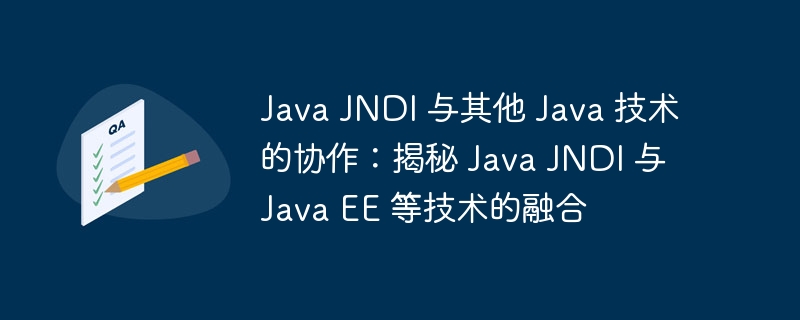Home >Java >javaTutorial >Java JNDI working with other Java technologies: Demystifying the integration of Java JNDI with technologies such as Java EE
Java JNDI working with other Java technologies: Demystifying the integration of Java JNDI with technologies such as Java EE
- 王林forward
- 2024-02-25 13:13:201022browse

Introduction to Java JNDI
Java JNDI (Java Naming and Directory Interface) is an API in Java used to access naming and directory services. Cooperation with technologies such as Java EE is crucial. In actual development, Java JNDI can be seamlessly integrated with the Java EE framework to provide applications with a more flexible resource access method. This article will delve into the collaboration between Java JNDI and other Java technologies, reveal the correlation and complementarity between them, and help developers better understand and apply these technologies.
Java JNDI and Java EE Collaboration
Java JNDI works closely with Java EE and plays an important role in Java EE applications. The Java EE specification defines JNDI as a standard naming and directory service API. Java EE applications can access data in various naming and directory services through JNDI.
Application of JNDI in Java EE
In Java EE applications, JNDI is mainly used in the following aspects:
- Resource lookup: Java EE applications can use JNDI to find various resources, such as data sources, Message queues, EJB components, etc. These resources are usually managed by the application server, and Java EE applications can access these resources through JNDI without caring about the specific location and access method of the resources. Service discovery:
- Java EE applications can use JNDI to discover other services, such as WEB services, EJB components, etc. These services are typically registered by the application server, and Java EE applications can find and communicate with these services through JNDI. Namespace management:
- Java EE applications can use JNDI to manage namespaces, such as global JNDI namespace and Web application JNDI namespace. Java EE applications can create, modify, delete, and access objects in the namespace through JNDI. Integration of Java JNDI and Java EE
The integration of Java JNDI and Java EE is mainly achieved through the following aspects:
- Java EE application server:
- Java EE application server usually provides a JNDI service for managing namespaces and resources. Java EE applications can find resources and services through JNDI services. Java EE specification:
- The Java EE specification defines JNDI as a standard naming and directory service API. Java EE applications can use JNDI to access data in various naming and directory services. JNDI API:
- The Java JNDI API provides a rich set of classes and interfaces for accessing data in naming and directory services. Java EE applications can implement functions such as resource lookup, service discovery, and namespace management through the JNDI API. Java JNDI collaboration with other Java technologies
In addition to Java EE, Java JNDI also has close collaboration with other Java technologies, such as Java RMI, Java CORBA, Java Servlet, etc.
Collaboration between Java JNDI and Java RMI
Java JNDI cooperates with Java RMI (Remote Method Invocat
ion) to enable Java programs to call methods of remote objects through the network. In Java RMI, remote objects can be registered in the JNDI namespace, and other Java programs can find remote objects through JNDI and call methods of remote objects. Collaboration between Java JNDI and Java CORBA
Java JNDI collaborates with Java CORBA (Common Object Request Broker Architecture) to enable Java programs to communicate with CORBA objects written in other languages (such as
c, C#, etc.). Java CORBA objects can be registered in the JNDI namespace, and other Java programs or CORBA programs written in other languages can find CORBA objects through JNDI and call methods of CORBA objects. Collaboration between Java JNDI and Java Servlet
Java JNDI collaborates with Java Servlets to enable Servlets to access various resources, such as data sources, message queues, etc. Servlets can find resources through JNDI and use these resources.
SummarizeJava JNDI, as a common naming and directory service API on the Java platform, not only has close collaboration with Java EE, but also has close collaboration with other Java technologies (such as Java RMI, Java CORBA, Java Servlet, etc.). In
projectdevelopment, Java JNDI plays an important role, helping Java programmers to easily access and manipulate data in naming and directory services, and realize resource search, service discovery and naming. Space management and other functions. >Soft Exam Advanced Examination Preparation Skills/Past Exam Questions/Preparation Essence Materials" target="_blank">Click to download for free>>Soft Exam Advanced Exam Preparation Skills/Past Exam Questions/Exam Preparation Essence Materials
The above is the detailed content of Java JNDI working with other Java technologies: Demystifying the integration of Java JNDI with technologies such as Java EE. For more information, please follow other related articles on the PHP Chinese website!
Related articles
See more- PHP environment configuration tutorial: PHP development environment integrated installation and independent installation video tutorial
- PHP integrated development environment encyclopedia
- What do you need to learn about Java ee?
- What are the characteristics of integrated operational amplifiers working in the nonlinear region?
- How to use PHP to implement directory service communication based on LDAP protocol

